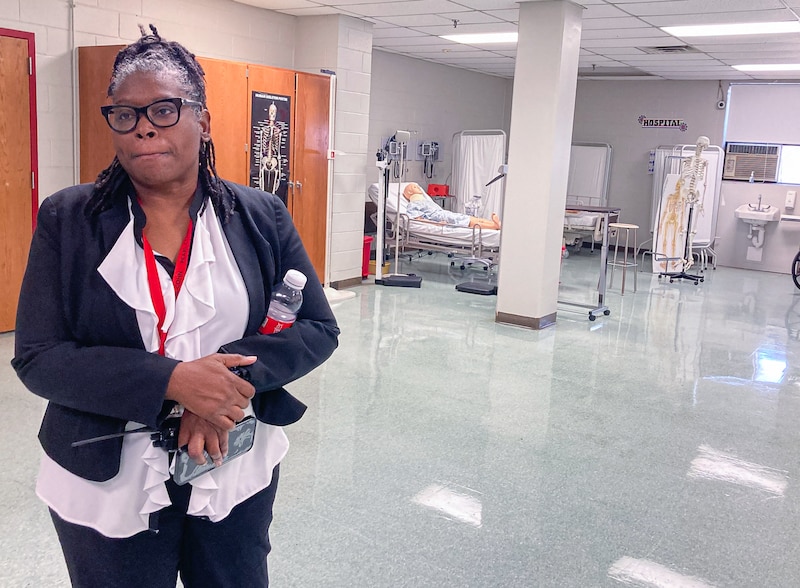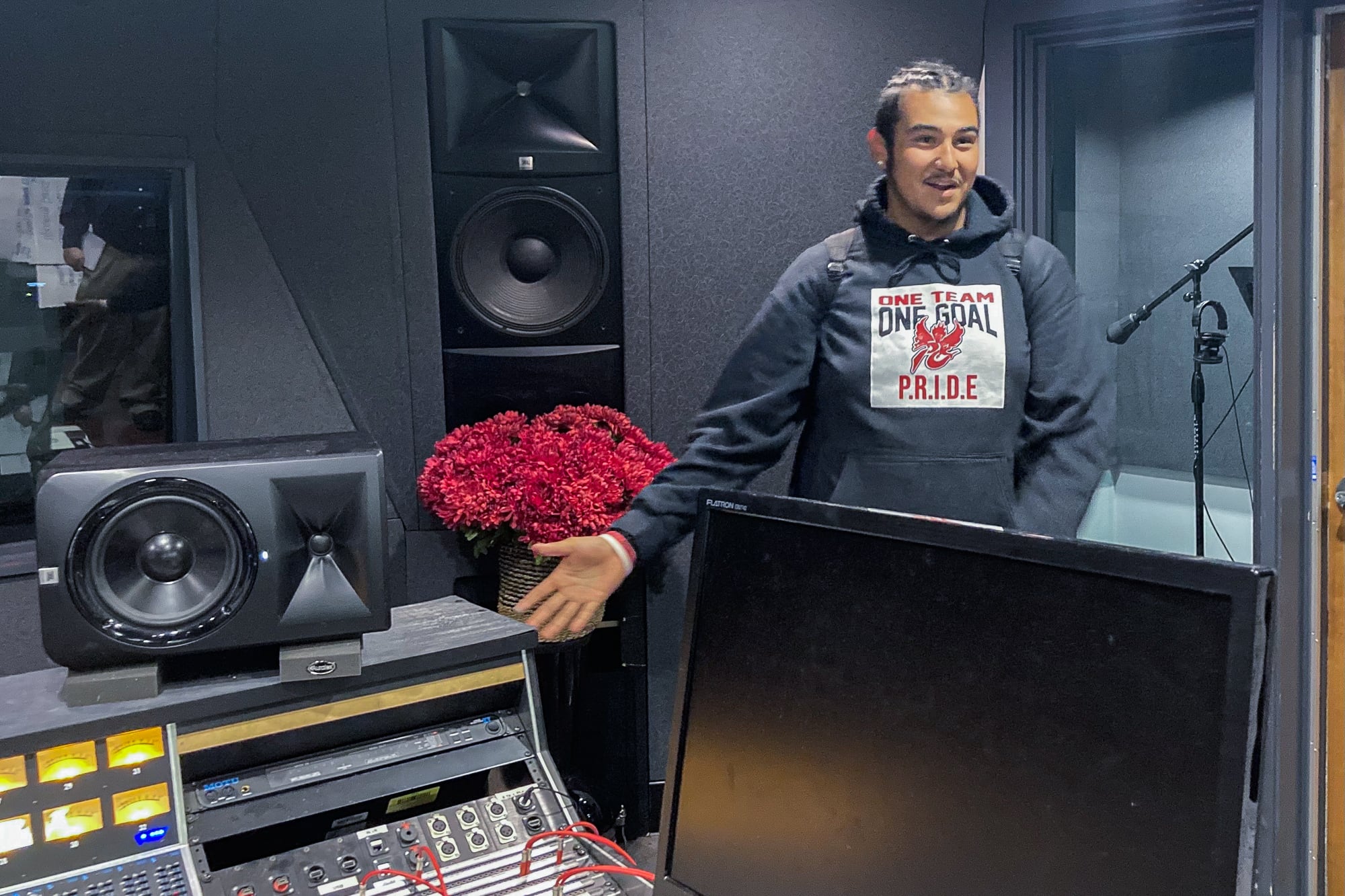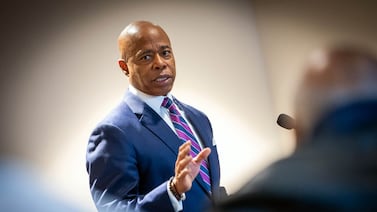Israel Perez, a high school senior in Nashville, feels he is closing in on his dream of becoming a music producer.
He landed a music business internship at Capitol Records earlier this year and has a part-time gig helping a local church edit and post videos of its sermons. His school, Pearl-Cohn High School, helped him find both.
The campus also boasts the country’s first high school student-run record label affiliated with a major record label, where Perez recently helped produce an R&B single — a collaboration between Warner Music and Pearl-Cohn’s Relentless Records.
As Chicago steps up its own push to connect students to jobs through career and technical education, Nashville offers a helpful case study.
CEO Pedro Martinez has talked about converting some of the district’s shrinking high schools on the South and West sides into career academies in the mold of Nashville’s Pearl-Cohn. There, more students would take courses and get work experience that forge pathways into high-demand industries.
In Chicago and nationally, the resurgence of career and technical education, or CTE, programs, comes as districts have moved away from a mindset that all students should attend a four-year college. That trend gained more traction amid a pandemic that saw employers grappling with crippling worker shortages — and students yearning for faster, debt-free routes to well-paying careers.
Metro Nashville Public Schools is a trailblazer in betting big on the career academy model. But its experience also offers some lessons for Chicago as officials there are still trying to get better at connecting students with meaningful work-based experiences — and reach the teens schools most struggle to engage.
Deborah Crosby, the work-based learning coordinator at Metro Nashville Public Schools acknowledged recently that getting schools, employers, and city officials on the same page is a work in progress.
“We want to bring them all together as an opportunity to serve all,” Crosby said.
An upgrade of Chicago’s career and technical education programs is part of Martinez’s three-year “blueprint” for reimagining learning, which also includes plans to revitalize neighborhood schools and improve services for students with disabilities.
After unveiling the plan’s broad outlines at the start of the school year, Chicago Public Schools leaders have so far shared no details on its rollout.
But in a statement emailed to Chalkbeat on Thursday, the district said work is already underway, and it is preparing counselors to provide both college and career guidance to students. The district also said it is working to expose more middle school students to possible careers, such as at a City Colleges of Chicago event this week, and to offer college credit for some of its high school manufacturing, health care, and IT courses.
It isn’t enough to prepare students for a career without giving them hands-on experience, Martinez told his school board in August. “They actually have to do it,” he said. “You want them to be engineers? You put them in an engineering internship.”
Nashville leads in growth of career academies
In the mid-2000s, Nashville’s high schools were struggling, with a graduation rate well below 60% and a looming takeover by the state of Tennessee. In a bid to change that, the district undertook a major overhaul that would chart a clearer path from freshman year to the careers students might pursue after high school.
Fifteen years later, a dozen of the district’s about 20 high schools house 35 “academies” that prepare students for various careers, with the goal of helping them get college credit, industry certifications, and hands-on work experiences before they get their diplomas.
The district’s high school transformation inspired plaudits from the White House and visits from education officials in other cities seeking to replicate its model. Chicago district officials toured Nashville high schools and spoke with colleagues about career learning in that district in 2017, according to a district spokesperson.
The district’s on-time graduation rate rose to almost 82% in 2021. (Data for spring 2022 is not yet available.) Suspensions declined. Attendance ticked up as well, though as in other districts it dipped during the pandemic. The district touts hundreds of partnerships with employers and colleges.
Interest in the career academy model has spiked nationally in recent years, said Deanna Schultz, who leads the master of science in Career and Technical Education program at the University of Wisconsin at Stout. Districts and charter operators are launching both new academies and converting existing schools, she said, adding that the model was also transformative for high schools in Racine, Wisconsin.
“If students find the right career pathway and coursework, they get excited about the future and become more engaged,” Schultz said.
That sense of relevance and meaning could help boost some struggling Chicago high schools, where enrollments have dropped dramatically over the past decade and attendance has lagged the district’s average. Some of these schools already are career academies, but have seen offerings scaled back in more recent years – in some cases, remaining career campuses largely in name only.
But transforming a traditional high school into a career academy is also a really heavy lift, said Schultz: It requires long and careful planning, educators qualified to teach specialized classes, colleagues willing to collaborate with them, and partnerships with local employers and campuses.
The National Career Academy Coalition, a nonprofit based in Nashville, estimates there are now 7,000 career academies enrolling roughly a million students across the country. Research has shown that the model can boost students’ academics and earning potential.
Different cities have taken a somewhat different approach, but some elements are key: They aim to prepare students for both college and careers, and they work to forge partnerships with both campuses and employers. Usually, they are schools-within-larger-high-schools, but some are “wall-to-wall” academies such as Nashville’s.
But district officials in Nashville are upfront: In some ways, the city’s career academy push is still a work in progress.
Data tracking students’ career trajectories is spotty
Perez, the Nashville senior, had dreamed of becoming a music producer since elementary school. More recently, he used money saved up from a dining hall job to buy recording equipment for his home.
But his modest home setup paled in comparison to what he found at Pearl-Cohn’s state-of-the-art recording studio when he first arrived at the high school last school year to join its entertainment industry pathway.
“I didn’t expect that. I was in heaven,” he said. “This studio is the real deal — top-tier stuff.”
The school’s Relentless Records releases original music created, performed, and produced by students, with music videos that students conceive, direct, and shoot. Like other academies, the school tries to connect core academics to its students’ career pathways, such as a data project with Atlantic Records in which students track music downloads to learn how executives determine who gets a record deal — and to learn math as well.
But when the school took stock of student outcomes in recent years, one thing was clear: Not many students were actually finding their way to jobs in the music industry. The school connected relatively few with internships and other meaningful work-based learning experiences.

Nashville has also struggled to track what career academy students do after graduation and has no data it can share on their college and career trajectories.
Chicago has faced similar challenges, even as the federal government pushes districts to better track how these students fare after high school. Earlier this year, based on a string of Freedom of Information Act requests, Chalkbeat found the district has no reliable data on its career and technical education students’ high school experiences or post-graduation outcomes — not even how many apply to these district programs.
Nashville has seen signs its career offerings are improving. Significantly more students take tests to gain industry certifications — a rise the pandemic did not dampen as it did in Chicago and other cities. Still, as more students take the tests, the portion who pass them has dipped, to about half.
In the Nashville district’s academies, freshmen take a career exploration seminar class and attend a massive career fair to pick a career pathway. Sophomores visit employers in their chosen field, juniors shadow a professional in that field, and seniors do a capstone research project or an internship. But, district officials said, schools were trying to connect students with often unpaid work experiences on a somewhat ad hoc basis.
The district is hoping to change that.
With a grant from JPMorgan Chase, it launched a more formal, paid work-based learning program last school year, starting with 68 students at four high-poverty schools, including Pearl-Cohn. Thirteen businesses hosted the interns, who also take a class that teaches them how to conduct themselves professionally on the job. This year, about 80 students are participating in the program, with hopes to expand it dramatically in coming years.
Nashville links career education to labor market
Since the pandemic hit, Gena Shearon, the human resources director at Holiday Inn Vanderbilt in Nashville, said hiring has been a huge challenge.
Enter nearby Hillwood High School. As part of the district’s new grant-funded work-based learning program, the hotel has two interns from the high school, vetted and supervised by the school district, which can also step in if any workplace issues arise.
“I am desperate for people, and she is recruiting for me,” Shearon said, pointing to Crosby, the district’s work-based learning coordinator. “This checks all the boxes for us.”
Hillwood senior Brayden Weaver is one of those interns. He wraps up his high school courses by 12:30 p.m. before reporting to work as a groundskeeper, where he checks the hallway ice machines, replaces bathroom faucets, and does other simple repairs. Weaver gets $16 an hour, free meals, and academic credit. He is in the school’s engineering pathway, eyeing trade school after graduation and a career in construction.
The Holiday Inn Vanderbilt has long had a relationship with Hillwood — one of four Nashville high schools with a hospitality focus — hosting field trips and unpaid interns over the years. Shearon said a student from a few years back started in a job clearing tables and washing dishes in the hotel restaurant while in high school, got promoted repeatedly in college, and now works as a manager of a luxury hotel in town.
But those earlier interns were usually unpaid, and the hotel had to take the lead in enlisting them.
Indeed, Crosby said, persuading employers to join the work-based learning program was fairly easy, even though hiring 17-year-olds involves significant red tape. In Nashville, she said, “Our growth has been crazy. A lot of entry-level positions have gone unfilled. Everywhere you go, there’s a Help Wanted sign.”
But the program has been a harder sell for students and their families because of its novelty and concerns about getting in the way of academics.
Ideally, the program would draw and help reengage teens who are struggling in school. But, Crosby said, the district wants to “put its best foot forward” with that initial group of employers, placing strict attendance and GPA requirements for participating students.
“Right now, that cuts off a lot of people,” she said. “The students who need this the most are being left out.”
That’s true in Chicago, too. Alternative school students have limited access to career offerings, leaving teachers at those schools to cobble together meaningful work experiences for students who have struggled to stay in school.
Ironically, career and technical programs were not that long ago considered a fit for struggling, disengaged students who weren’t “college material.” Their reputation has come a long way, as a gateway to both college and high-earning careers.
Nashville’s Pearl-Cohn, which serves a predominantly Black and low-income student body, has worked to be more effective as such a gateway. Last year, the school launched a new health sciences career pathway, which for some students might offer better odds of getting a head start on their careers.
The school set up partnerships with nearby medical schools and a mock health clinic in a spacious hall on campus, with four medical manikins in hospital beds as well as phlebotomy, trauma, and occupational therapy areas. Last year, the school’s first Latina valedictorian graduated with an associate degree as a medical assistant, and school leaders want more students to do that.
Pearl-Cohn plans to track much more closely what happens with its students when they leave. Slightly more than half of the first group of students who completed the health care program landed jobs as medical assistants or continued on studying in the healthcare field — a promising start.
“My goal and vision is that when our kids leave, they are ready to enter the job market in our local area,” said principal Miriam Harrington. “The goal is to end generational poverty and ensure generational wealth.”
That’s a vision Chicago’s Martinez has sketched out as well: graduates who are able to choose college or careers — and in some cases, go back and forth seamlessly between campus and the workplace, building up their skillset.
Mila Koumpilova is Chalkbeat Chicago’s senior reporter covering Chicago Public Schools. Contact Mila at mkoumpilova@chalkbeat.org.








